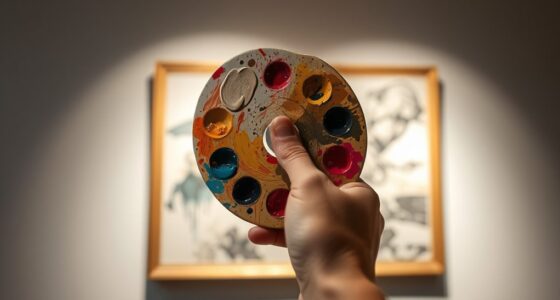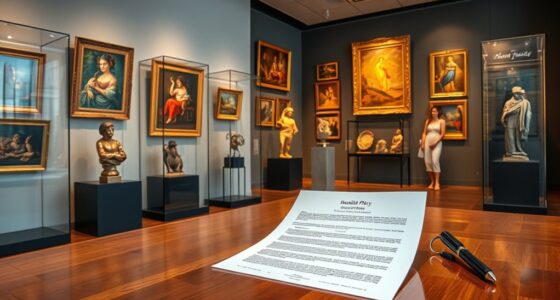To estate plan for your art collection, start by accurately appraising and documenting each piece, including provenance and condition, with professional help if needed. Decide whether to hold artworks personally, in a trust, or through an LLC to protect assets and streamline transfers. Clearly designate beneficiaries and specify how you want your collection distributed or donated. Continuously update your plans and records—if you want to learn more about protecting your art legacy, keep exploring these strategies.
Key Takeaways
- Establish clear ownership structures, such as trusts or LLCs, to manage and protect art assets effectively.
- Obtain professional appraisals and accurate valuations to inform estate taxes and ensure proper insurance coverage.
- Create detailed documentation, including provenance, certificates, and photographs, to verify authenticity and value.
- Designate specific beneficiaries and include instructions for art transfer, donation, or public display in estate plans.
- Consult legal and financial professionals to develop comprehensive strategies that safeguard the collection and optimize estate transfer.
Assessing the Value of Your Art Collection
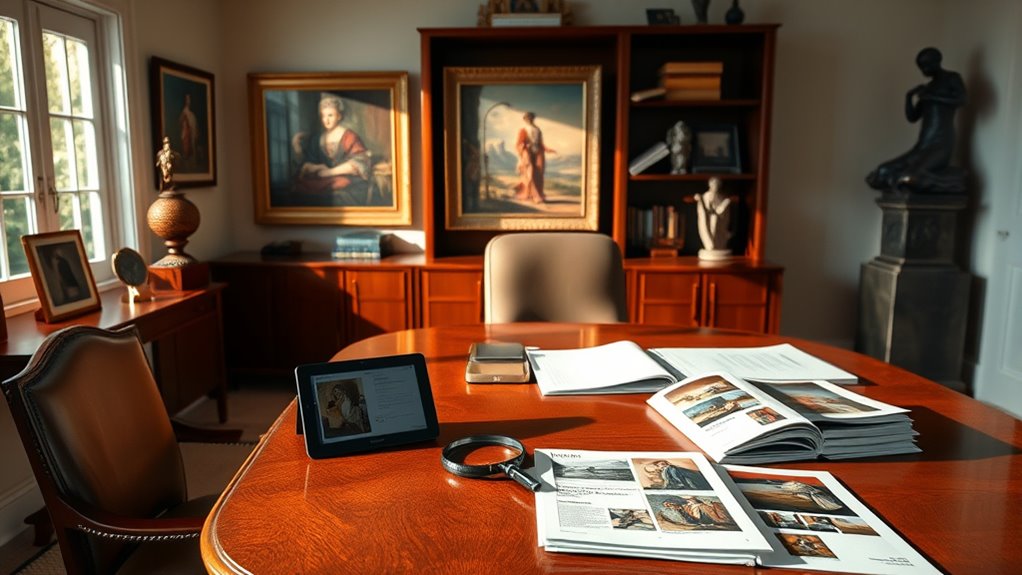
How do you determine the true worth of your art collection? You start by analyzing current art market trends, which influence how much similar pieces are selling for today. Keep an eye on auction results, gallery sales, and online platforms to gauge demand and pricing fluctuations. Additionally, consider the conservation techniques used to preserve your artworks, as well-maintained pieces tend to hold or increase their value. Professional appraisals can provide an accurate assessment based on these factors, but staying informed about market dynamics helps you make smarter decisions. Remember, the value of your collection isn’t just about the art itself; its condition, provenance, and relevance in the current art scene also play vital roles. All these elements combined give you a thorough picture of your collection’s worth. Incorporating technology-driven valuation tools can further enhance the accuracy of your assessments and keep you updated on market shifts.
Creating a Detailed Inventory and Documentation

To protect your art collection, you need to create a detailed inventory that includes all your pieces. Take clear photographs of each item and record important provenance details to verify authenticity and ownership. This thorough documentation will simplify estate transfer and help prevent disputes down the line. Additionally, incorporating cultural sensitivity into your records can enhance understanding of each piece’s significance within personal and cultural identities.
Catalog All Artwork
Creating a detailed inventory of your art collection is a crucial step in estate planning. Start by listing each piece with key details like title, artist, date, dimensions, and provenance. Include digital authentication information when available, as it can verify authenticity and value. Accurate documentation helps streamline estate settlement and ensures your assets are protected. Additionally, having a thorough catalog supports your art insurance, making claims faster if your artwork is damaged or stolen. Keep records organized physically and digitally, and update them regularly. By cataloging all your artwork diligently, you provide clarity for heirs, appraisers, and legal professionals, ultimately safeguarding your collection’s legacy and ensuring your estate plan is complete and effective. Maintaining proper documentation can also aid in the event of disputes or audits related to your estate.
Photograph Each Item
Photographs serve as essential visual records that complement your written catalog of artwork. To guarantee thorough documentation, you should photograph each item from multiple angles, capturing details that help identify and authenticate pieces later. Use good lighting and a neutral background to highlight colors and textures accurately. When photographing fragile or valuable items, consider display case considerations—placing items in transparent, secure cases can protect them while allowing clear images. Keep digital copies organized and labeled with relevant details like artist, date, and provenance. These photos not only help create a comprehensive inventory but also serve as proof of ownership if needed for insurance or estate purposes. Additionally, utilizing high-resolution images with consistent lighting conditions can improve the quality and usefulness of your documentation. Regularly update your photographs to reflect any changes or additions to your collection.
Record Provenance Details
Have you documented the provenance details of each artwork in your collection? Accurate provenance tracking is essential for verifying authenticity and establishing clear ownership history. Create a detailed inventory that includes acquisition records, previous owners, exhibition history, and any restoration work. Keep digital and physical copies of certificates, appraisals, and provenance reports. This documentation helps prevent future disputes and simplifies estate transfer. When verifying authenticity, well-maintained provenance records serve as critical proof, boosting confidence in your collection’s value. Regularly update these records as you acquire new pieces or receive new information. Precise provenance tracking not only safeguards your assets but also enhances their desirability and marketability. In estate planning, thorough documentation ensures your collection’s integrity and smooth transfer to heirs.
Choosing the Right Legal Structures for Art Ownership

When selecting a legal structure for your art collection, it’s vital to take into account how ownership will impact your estate planning, taxes, and transfer processes. Your choice affects legal considerations like liability, privacy, and control. Common ownership structures include individual ownership, LLCs, and trusts. Each offers distinct advantages: LLCs provide liability protection and ease of transfer; trusts enable seamless estate management and privacy; and individual ownership is straightforward but less flexible. Carefully evaluate these ownership structures based on your goals, the value of your collection, and potential tax implications. Additionally, understanding the support hours available for legal and financial professionals can help you plan consultations more effectively. The right legal structure ensures your art is protected, simplifies transfer procedures, and aligns with your overall estate plan. Consulting with legal and financial professionals helps you make the best choice.
Incorporating Art Into Your Estate Plan
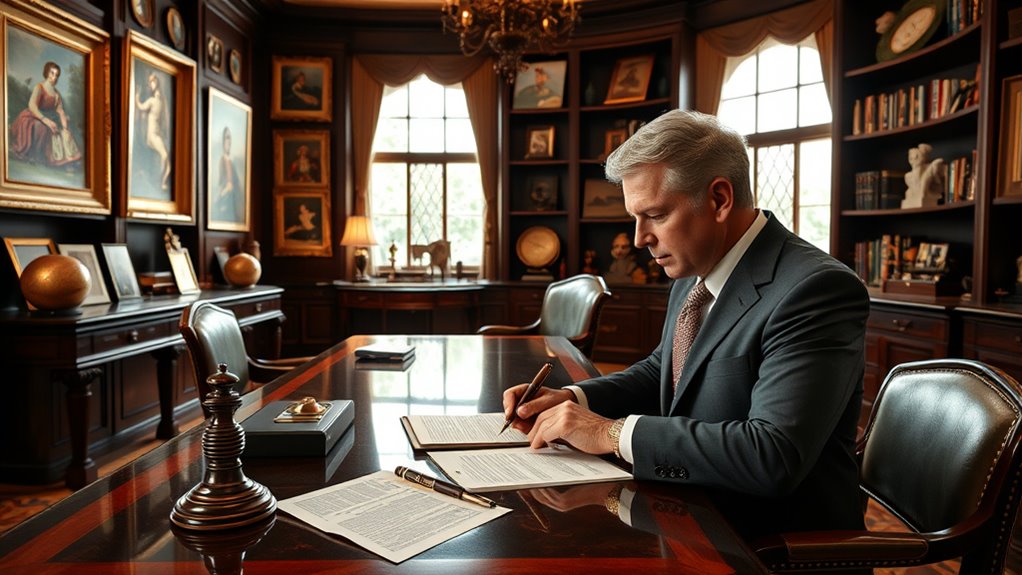
To effectively incorporate your art collection into your estate plan, you need accurate appraisal and valuation methods to establish its worth. You should also designate specific beneficiaries for your artwork and consider establishing art trusts to manage transfer and preservation. These steps ensure your collection is protected and passes smoothly to your heirs. Additionally, understanding textile art techniques can help you appreciate the craftsmanship behind your collection and make more informed decisions about its inclusion in your estate.
Appraisal and Valuation Methods
Accurately appraising and valuing your art collection is vital for integrating it effectively into your estate plan. To do this, consider current market trends, which influence artwork demand and prices. These trends can fluctuate based on economic conditions, collector interest, and emerging art genres. Additionally, the reputation of the artist plays a key role; works by renowned artists often command higher values. Professional appraisers specialize in evaluating these factors and providing precise valuations. Using reputable appraisal services guarantees your art’s worth is accurately reflected for estate tax purposes, insurance, and inheritance planning. Regular updates to appraisals are necessary to keep pace with market changes. Proper valuation helps you make informed decisions, ensuring your collection is protected and properly allocated within your estate. Incorporating vertical storage solutions can also help maintain your collection’s condition and accessibility.
Designating Art Beneficiaries
Once you’ve established the value of your art collection through proper appraisal, the next step is to clearly designate who will receive these pieces after your passing. You should specify beneficiaries in your estate plan to ensure your art display preferences are honored, whether for private enjoyment or public benefit. If you want your art to contribute to museum acquisitions, include instructions for donation or transfer to institutions. Clear designation prevents misunderstandings and streamlines the transfer process, safeguarding your intentions. Consider creating a detailed list of your art pieces, including descriptions and suggested recipients. This clarity helps your heirs or trustees manage your collection efficiently and aligns distribution with your wishes, whether for personal display or supporting cultural institutions. Additionally, understanding the proper documentation for art transfer can facilitate a smoother estate settlement process.
Incorporating Art Trusts
Incorporating art trusts into your estate plan provides a powerful way to guarantee your collection is managed according to your wishes and preserved for future generations. An art trust allows you to specify how your artworks are protected, including arrangements for art insurance and handling fluctuations in art market trends. This setup ensures your collection remains secure and well-maintained, even if you’re no longer involved. Additionally, an art trust can streamline the transfer process, minimizing estate taxes and legal complications. Understanding the nuances of art trusts helps you tailor your estate plan effectively. Asset protection safeguards artworks from market volatility
Appraisal and Tax Considerations
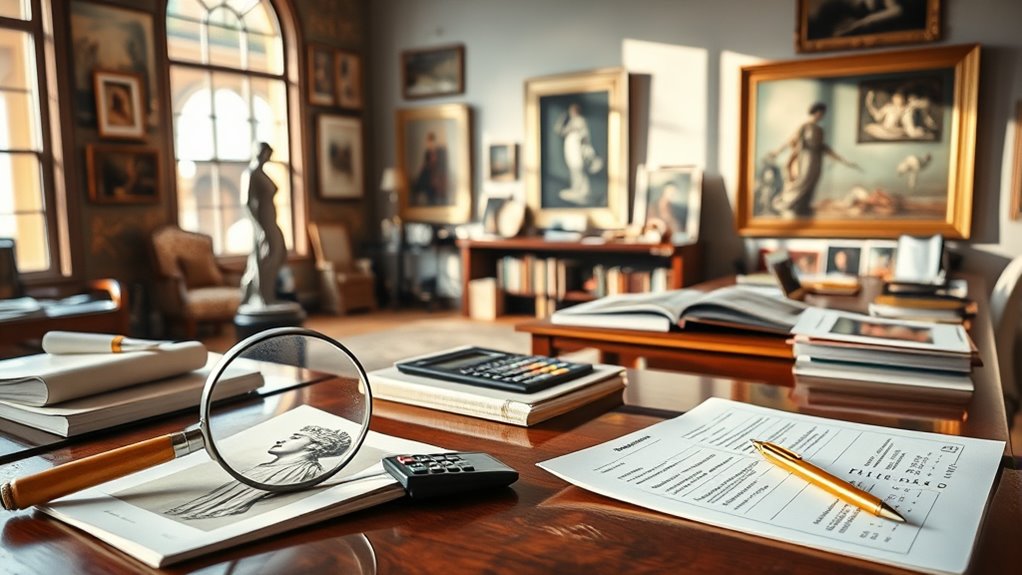
Understanding the appraisal process and tax implications is essential when managing an art collection for estate planning. Accurate appraisals determine the value of your art, impacting estate taxes and insurance coverage. Regular appraisals help guarantee your art is properly insured, reducing risks during transportation or conservation efforts. When valuing artworks, consider factors like provenance, condition, and market trends. Proper conservation planning can also preserve your collection’s value, potentially lowering future tax burdens. Keep thorough documentation of appraisals and conservation efforts to support tax filings and insurance claims. Being proactive with these considerations assures your collection is accurately valued, protected, and compliant with tax laws, minimizing liabilities and maximizing the legacy you intend to leave behind. Remote work can influence your ability to conduct research and collaborate with appraisers and tax professionals efficiently.
Selecting Beneficiaries and Designating Art Distributions
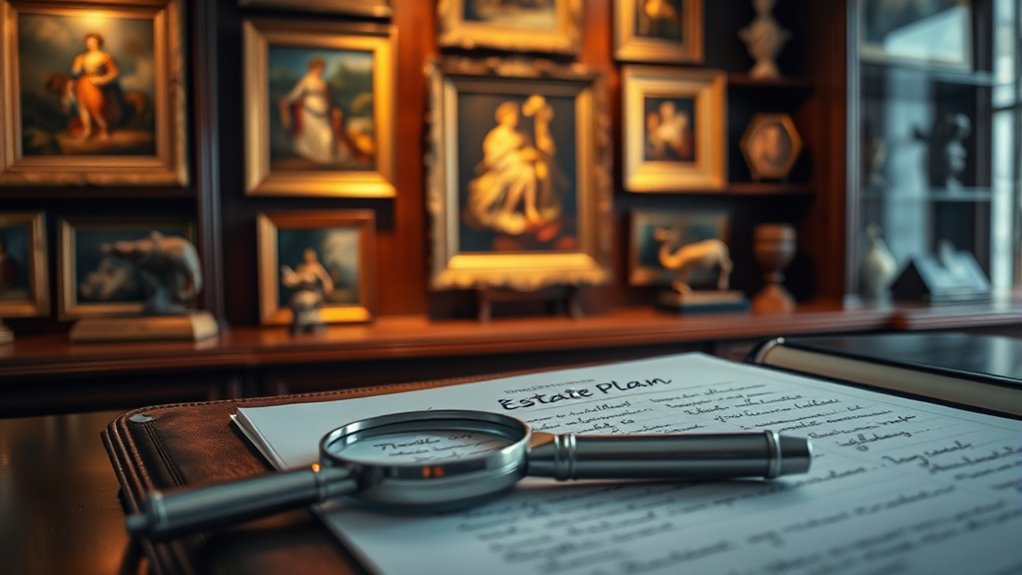
After obtaining accurate appraisals and understanding tax implications, the next step is to carefully select beneficiaries and plan how your art collection will be distributed. Consider whether beneficiaries are familiar with digital authentication methods, which can verify the provenance and authenticity of your artwork. This ensures recipients can confidently manage or sell pieces later. Additionally, you must navigate international art laws if your collection includes works from different countries. These laws impact transfer procedures, taxes, and legal requirements, so designate beneficiaries who understand or are prepared for these complexities. Clearly specify distribution instructions to prevent disputes, including details about digital authentication certificates and legal considerations across borders. Proper documentation of legal requirements and international regulations is essential to avoid future complications. Precise planning now will streamline the transfer process and protect your collection’s legacy.
Working With Art and Estate Planning Professionals

Have you considered how working with specialized professionals can simplify your art estate planning process? Experts like art appraisers, estate attorneys, and financial advisors understand current art market trends and how they impact your collection’s value. They can help you accurately assess your artworks and navigate complex tax implications, ensuring your estate plan aligns with your goals. Professionals familiar with artist reputation can advise you on the significance of provenance and market demand, which influence valuation and inheritance strategies. Collaborating with these specialists guarantees your collection is protected, properly documented, and positioned for smooth transfer to heirs. Their expertise makes the process more efficient, reduces surprises, and helps maximize your collection’s legacy for future generations. Additionally, leveraging voice over techniques can enhance your storytelling when sharing the history and significance of your collection with heirs or potential buyers.
Strategies for Protecting and Preserving Your Collection
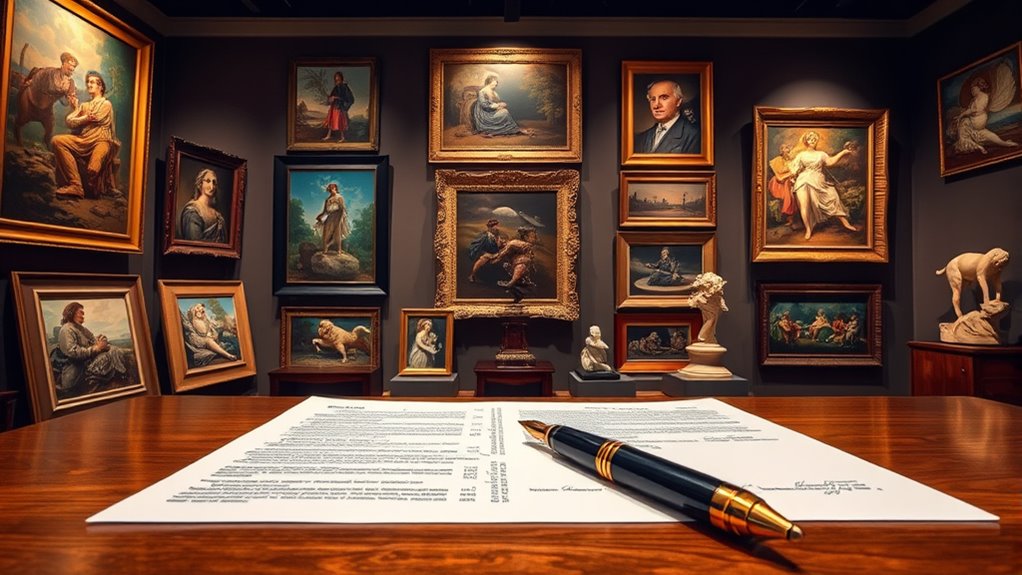
Protecting and preserving your art collection requires proactive strategies to maintain its value and integrity over time. Regular art conservation is essential; it involves professional assessments and proper environmental controls to prevent deterioration. Keep artworks away from direct sunlight, extreme temperatures, and humidity, which can cause damage. Additionally, securing comprehensive insurance coverage is crucial; it protects your collection against theft, damage, or loss. Review your policy periodically to guarantee it reflects the collection’s current value and risks. Proper storage and handling also play important roles—use appropriate materials and avoid unnecessary movement. Understanding emotional manipulation used by narcissists can help you recognize and avoid emotional traps that might distract from protecting your assets. By combining art conservation practices with robust insurance coverage, you safeguard your collection’s longevity and value for future generations. These steps help ensure your collection remains protected and well-preserved.
Frequently Asked Questions
How Can I Ensure My Art Collection Remains Private After My Passing?
To keep your art collection private after you pass, you should implement privacy safeguards like trusts or limited disclosure estate documents. These tools help maintain estate confidentiality by controlling who accesses your collection’s details. Work with an estate planning attorney experienced in art assets to create a plan that minimizes public records and keeps your collection out of the spotlight, ensuring your privacy is preserved for generations to come.
What Are the Risks of Gifting Art During My Lifetime?
Imagine the risks lurking behind gifting art during your lifetime. You might face unexpected gifting taxes, which could markedly reduce your assets. Plus, inaccurate art valuation can lead to over- or underestimating your gift’s worth, triggering legal issues or financial surprises later. You could also lose control of your art, risking its confidentiality and future care. Carefully consider these factors before making such a move—what seems simple might have hidden consequences.
How Do I Handle Art Collections With International Provenance?
Handling art collections with international provenance involves understanding the complexities of cultural heritage laws and import/export regulations. You should verify the provenance to confirm authenticity and legal ownership, especially for pieces with cultural significance. Consult experts in international art law and consider working with reputable galleries or legal advisors to navigate potential restrictions, avoid repatriation issues, and protect your collection’s integrity and cultural value.
Can Digital Art or NFTS Be Included in Estate Planning?
Did you know that nearly 80% of digital assets owners plan to include NFTs in their estate plans? You can definitely include digital art or NFTs in your estate planning. Just make certain you track ownership details and digital wallet access. By doing so, you secure your NFT ownership, making it easier for your heirs to manage or transfer these assets smoothly, just like traditional art collections.
What Are the Implications of Donating Art to Museums or Charities?
When you donate art to museums or charities, you face tax implications that could benefit you through deductions, but valuation challenges may arise in establishing the artwork’s worth. You need to guarantee proper appraisal to maximize tax benefits and comply with regulations. By carefully managing these factors, you can support causes you care about while potentially reducing your taxable estate, making your donation both meaningful and financially advantageous.
Conclusion
Did you know that over 60% of art collectors haven’t fully integrated their collections into their estate plans? By evaluating your collection, working with professionals, and choosing the right legal strategies, you can guarantee your art passes smoothly to your loved ones. Taking these steps not only protects your valuable pieces but also preserves your legacy. Start planning today, and turn your passion for art into a lasting estate that future generations will cherish.


